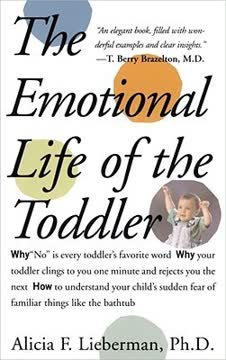Key Takeaways
1. Early Relationships are the Foundation of Emotional Growth
The most important emotional accomplishment of the toddler years is reconciling the urge to become competent and self-reliant with the simultaneous and sometimes contradictory longing for parental love and protection.
Secure base. The emotional bedrock of a toddler's life is built upon the quality of their early relationships, particularly with parents or primary caregivers. These relationships serve as a secure base, providing a sense of safety and security from which the child can explore the world. When parents respond with encouragement and understanding, this home base becomes a secure base.
Attachment theory. Attachment theory emphasizes the intense need children have for a close relationship with their parents. A secure attachment allows toddlers to grow into happy and competent children. This security fosters the self-confidence to explore and learn.
Lasting impact. The experiences of closeness and exploration during these formative years have long-term implications, shaping individual styles of expressing, balancing, and integrating the need for safety and the desire for adventure throughout life.
2. Toddlerhood: A Balancing Act of Autonomy and Connection
The most important emotional accomplishment of the toddler years is reconciling the urge to become competent and self-reliant with the simultaneous and sometimes contradictory longing for parental love and protection.
Walking and talking. Toddlerhood, marked by the ability to walk independently, represents a significant shift from the physical closeness of infancy. This new autonomy brings about a revolution in the toddler’s self-concept. The toddler herself can now determine when and where to go, without having to rely on the parent as the necessary means of transportation.
Emotional task. The major emotional task of this stage is integrating the excitement of exploring away from parents with the feeling of safety derived from their ongoing presence. Parents must protect their child from new dangers while fostering independence.
Dual impulses. Toddlers grapple with the duality of wanting to feel safe and protected while simultaneously yearning for unrestricted exploration. This push and pull between caution and daring shapes their individual style and influences their choices throughout life.
3. Navigating the Challenges: Understanding Toddler Behavior
Toddlers are defined by their capacity to walk without assistance.
Inexplicable behavior. Toddler behavior can often seem illogical to adults, with reactions that defy grown-up reasoning. Understanding the developmental perspective of a 1, 2, or 3-year-old is key to deciphering these actions.
Contests of wills. Parents often find themselves in power struggles with their toddlers, feeling embarrassed or frustrated by their inability to easily "win" these uneven matches. It is important to remember that toddlers' defiance and resistance to parental demands often reflect an age-appropriate wish to control events rather than problems in development or in the parent-child relationship.
Parental exhaustion. Parents, particularly mothers, often experience tension and fatigue while raising toddlers. Creating safe spaces for toddlers that decrease the need for constant parental intervention and redirecting their attention by enticing them away from forbidden pursuits are two efficient strategies to decrease parent and child mutual frustration.
4. Temperament Matters: Recognizing Individual Differences
Temperamental tendencies put an individual stamp on how toddlers use their parents and other caregivers as a secure base for their explorations.
Innate style. Temperament refers to the "how" of behavior, describing a child's individual style of reacting to the world. It encompasses traits like activity level, intensity of emotions, adaptability, and regularity.
Not destiny. While temperament is partly innate, it is not fixed. Environmental factors, particularly early relationships, can significantly shape how temperamental traits are expressed and managed.
Categories of temperament. While every child is unique, common temperamental styles include:
- Easy: Flexible, adaptable, and generally positive.
- Slow-to-warm-up: Cautious, reserved, and needing time to adjust.
- Intense: Highly reactive, emotional, and challenging.
- High-activity: Energetic, restless, and constantly on the move.
5. High-Activity Toddlers: Channeling Energy and Enthusiasm
Locomotion puts the toddler’s body at the center of her experience.
Constant motion. High-activity toddlers are characterized by their boundless energy and enthusiasm for exploration. They are constantly on the move, drawn to novelty, and seemingly fearless.
Challenges for parents. Parents of high-activity toddlers may feel overwhelmed by their child's constant need for stimulation and movement. It is important to create safe spaces for exploration and to find outlets for their energy.
Positive outlets. Channeling their energy into constructive activities, such as sports, outdoor play, and creative movement, can help high-activity toddlers thrive. Parents can also create safe spaces for toddlers that decrease the need for constant parental intervention and redirecting their attention by enticing them away from forbidden pursuits.
6. Slow-to-Warm-Up Toddlers: Respecting Their Need for Time
The profile of slow-to-warm-up temperament is helping slow-to-warm-up toddlers enjoy who they are.
Cautious approach. Slow-to-warm-up toddlers are characterized by their cautiousness and need for time to adjust to new situations. They may be wary of strangers, hesitant to try new activities, and prefer familiar routines.
Misinterpretations. It is important not to misinterpret their reserve as anxiety or insecurity. They simply need time to observe and assess before engaging.
Supportive strategies. Parents can support slow-to-warm-up toddlers by:
- Respecting their pace and avoiding pressure.
- Providing gradual exposure to new experiences.
- Creating a predictable and secure environment.
- Praising their efforts and celebrating small victories.
7. Early Anxieties: Addressing Fears and Insecurities
The most important emotional accomplishment of the toddler years is reconciling the urge to become competent and self-reliant with the simultaneous and sometimes contradictory longing for parental love and protection.
Common fears. Toddlerhood is a time of heightened anxiety, with common fears including separation anxiety, fear of the dark, fear of strangers, and fear of monsters. These fears stem from their growing awareness of potential dangers and their limited ability to cope.
Parental reassurance. Parents can help alleviate these anxieties by:
- Acknowledging and validating their child's feelings.
- Providing consistent reassurance and protection.
- Creating a safe and predictable environment.
- Using play and humor to address fears.
When to seek help. If anxiety becomes excessive, persistent, or interferes with daily functioning, seeking professional help from a child mental health specialist is recommended.
8. Toilet Training, Sleep, and Eating: Negotiating Common Hurdles
The loving mother teaches the child to walk alone.
Developmental milestones. Toilet training, sleep routines, and eating habits are common areas of negotiation and potential conflict during the toddler years. Approaching these milestones with patience, understanding, and flexibility is key.
Toilet training. Readiness is crucial for successful toilet training. Look for signs of physical and emotional maturity, and avoid pressure or punishment.
Sleep routines. Establishing a consistent bedtime routine and addressing nighttime fears can help toddlers develop healthy sleep habits.
Eating habits. Avoid power struggles over food. Offer a variety of nutritious choices and allow the toddler to self-regulate their intake.
9. Divorce: Minimizing the Impact on Toddlers
Divorce as Secure Base Disruption.
Toddlers' perspective. Divorce can be a deeply unsettling experience for toddlers, disrupting their sense of security and stability. They may struggle to understand the changes and fear abandonment.
Parental support. Parents can minimize the impact of divorce by:
- Maintaining a consistent and predictable routine.
- Providing reassurance of their love and commitment.
- Avoiding conflict in front of the child.
- Supporting the child's relationship with both parents.
Co-parenting. Establishing a cooperative co-parenting relationship, even if challenging, is crucial for the child's well-being.
10. Child Care: Creating a Supportive Environment
The Emotional Effects of Child Care.
Quality matters. The quality of child care significantly impacts a toddler's emotional development. Look for caregivers who are warm, responsive, and attuned to the child's individual needs.
Secure base. The child-caregiver relationship should provide a secure base from which the toddler can explore and learn.
Open communication. Maintaining open communication with the caregiver and actively participating in the child care setting can help ensure a positive experience.
Last updated:
FAQ
1. What is The Emotional Life of the Toddler by Alicia F. Lieberman about?
- Explores toddler emotions: The book delves into the complex emotional world of toddlers aged 1 to 3, explaining their capacity for joy, wonder, and difficult emotions.
- Attachment theory foundation: Lieberman uses attachment theory to frame how toddlers rely on caregivers as a secure base for exploration and emotional growth.
- Parent-child relationship focus: It examines the evolving partnership between parents and toddlers, addressing family dynamics, cultural influences, and the impact of life changes.
- Practical guidance: The book offers actionable advice for common challenges like tantrums, separation anxiety, and sibling rivalry.
2. Why should I read The Emotional Life of the Toddler by Alicia F. Lieberman?
- Insight into toddler behavior: The book helps parents and caregivers understand the emotional and developmental roots of puzzling toddler behaviors.
- Evidence-based strategies: Lieberman provides research-backed, compassionate methods for managing tantrums, fears, and oppositional behavior.
- Support for family changes: The book offers guidance for navigating transitions such as divorce, new siblings, and child care.
- Cultural sensitivity: It respects diverse family structures and cultural backgrounds, making its advice widely applicable.
3. What are the key takeaways from The Emotional Life of the Toddler by Alicia F. Lieberman?
- Balancing autonomy and attachment: Toddlers are driven to explore independence while needing parental love and security.
- Temperament and environment: Each child’s temperament interacts with parenting style and culture, shaping emotional development.
- Secure base concept: A trusted caregiver provides the foundation for toddlers to explore, learn, and self-regulate.
- Play and emotional mastery: Play is essential for toddlers to process anxiety, express feelings, and develop resilience.
4. What are the best quotes from The Emotional Life of the Toddler by Alicia F. Lieberman and what do they mean?
- “Toddlers live in the moment, finding wonder in the ordinary and terror in the unexpected.” This highlights the intensity and immediacy of toddler emotions.
- “A secure base is not a place, but a relationship.” Emphasizes that emotional security comes from consistent, responsive caregiving.
- “Discipline is not punishment, but teaching.” Lieberman reframes discipline as guiding toddlers toward self-control, not simply correcting behavior.
- “Play is the toddler’s language.” Underlines the importance of play for emotional expression and coping.
5. How does Alicia F. Lieberman define and explain the concept of a "secure base" in The Emotional Life of the Toddler?
- Definition of secure base: A secure base is the caregiver’s role as a reliable source of safety and comfort, enabling confident exploration.
- Behavioral indicators: Toddlers move away to explore and return for reassurance, reflecting their need for both autonomy and security.
- Internalization over time: Through repeated interactions, children develop an internal sense of safety and confidence, supporting resilience even when parents are absent.
- Foundation for emotional health: Secure attachment is linked to better emotional regulation and social skills.
6. What does The Emotional Life of the Toddler by Alicia F. Lieberman say about temperament and its impact on toddler development?
- Temperament as behavioral style: Temperament describes how children react to the world—intensity, adaptability, and mood—not just what they do.
- Types of temperament: Lieberman discusses easy, slow-to-warm-up, intense, and high-activity temperaments, each influencing how toddlers relate to caregivers.
- Interaction with environment: Temperament is shaped by parenting, culture, and context; a good fit between parent and child supports healthy development.
- Not destiny: Temperament can be managed and supported through sensitive caregiving and understanding.
7. How does Alicia F. Lieberman describe high-activity and slow-to-warm-up toddlers in The Emotional Life of the Toddler?
- High-activity toddlers: These children are energetic, intense, and drawn to movement, often requiring extra supervision and safe spaces for play.
- Parental challenges: Parents may feel exhausted or isolated due to the child’s constant motion and need for engagement.
- Slow-to-warm-up toddlers: These children are cautious, shy, and need more time to adapt to new situations, often suppressing strong emotions.
- Support strategies: Lieberman recommends respecting each child’s pace, providing gradual exposure, and fostering assertiveness and emotional awareness.
8. What guidance does The Emotional Life of the Toddler by Alicia F. Lieberman offer on managing tantrums, defiance, and discipline?
- Normal developmental phase: Tantrums and defiance are age-appropriate expressions of autonomy and emotional struggle.
- Empathetic, firm limits: Parents should maintain clear boundaries while acknowledging feelings, using strategies like distraction and negotiation.
- Discipline as teaching: Discipline is about helping toddlers develop self-regulation, not punishment or inducing guilt.
- Repair after conflict: Consistent, empathetic responses and repairing relationships after conflicts build trust and resilience.
9. How does The Emotional Life of the Toddler by Alicia F. Lieberman address toddler anxiety and separation anxiety?
- Anxiety as survival mechanism: Anxiety helps toddlers anticipate and cope with threats, but can become overwhelming if not managed.
- Separation anxiety: Peaks around 18 months, reflecting the struggle between independence and the need for reassurance.
- Gradual exposure and play: Lieberman recommends step-by-step support and using play to help toddlers master fears.
- Preparation and routines: Predictable routines, simple explanations, and tangible reminders help toddlers cope with separations.
10. What does Alicia F. Lieberman say about the impact of divorce and family changes on toddlers in The Emotional Life of the Toddler?
- Disruption of secure base: Divorce can cause feelings of loss, fear, and confusion, as toddlers rely on family unity for security.
- Parental cooperation is key: Children fare best when parents support the child’s relationship with both parents and communicate positively.
- Managing transitions: Strategies include easing custody transitions, providing clear explanations, and introducing new partners gradually.
- Emotional availability: Stability and emotional support help toddlers adjust to new family dynamics.
11. How does The Emotional Life of the Toddler by Alicia F. Lieberman describe the role of play in emotional development and coping?
- Play as emotional mastery: Play allows toddlers to process anxiety, practice problem-solving, and gain control over fears.
- Expression of complex feelings: Through play, toddlers can safely express anger, fear, and ambivalence.
- Parental involvement: Parents should support but not direct play, following the child’s lead and introducing protective themes when needed.
- Coping with stress: Play helps toddlers reenact and make sense of stressful experiences, aiding emotional resilience.
12. What are the best practical tips from The Emotional Life of the Toddler by Alicia F. Lieberman for common parenting challenges?
- Step-by-step encouragement: Gradually introduce shy or slow-to-warm-up toddlers to new situations, staying available but not hovering.
- Managing sleep and routines: Use consistent routines, calming rituals, and gradual techniques to help toddlers self-soothe and sleep better.
- Toilet training readiness: Wait for signs of readiness, use child-sized potties, and avoid coercion to prevent anxiety and power struggles.
- Parent-caregiver partnership: Communicate openly with caregivers, share information, and collaborate to support the child’s well-being.
Review Summary
The Emotional Life of the Toddler is widely praised for its insightful look into toddler psychology, offering parents a deeper understanding of their children's behavior and emotions. Readers appreciate the book's blend of academic research and practical examples, finding it compassionate and enlightening. Many note improved patience and empathy after reading. Some criticize outdated gender perspectives and desire more practical advice. Overall, reviewers recommend it as a valuable resource for parents navigating the challenges of toddlerhood, despite a few disagreements with certain approaches.
Similar Books
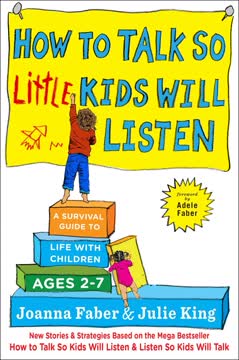
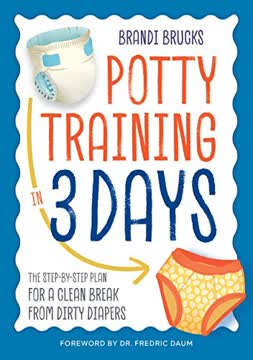

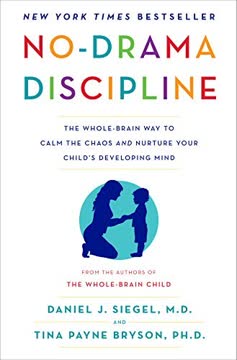
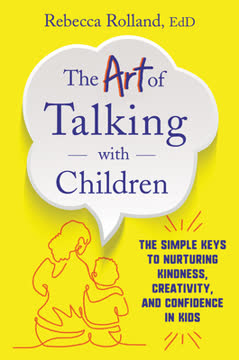

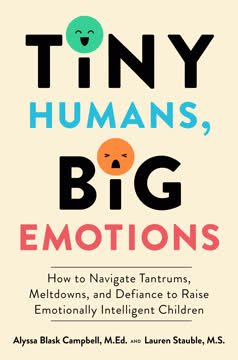
Download PDF
Download EPUB
.epub digital book format is ideal for reading ebooks on phones, tablets, and e-readers.
